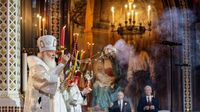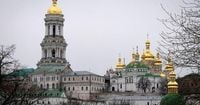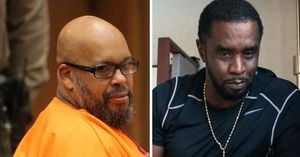On September 5, 2025, the Ukrainian government announced a move that could reshape the religious landscape of the country: a branch of the Orthodox Church, which officials say has failed to fully break from its ties with Moscow, may soon be banned. The decision, reported by the Associated Press, underscores the turbulent intersection of faith, identity, and geopolitics as Ukraine continues to fend off Russia’s ongoing invasion.
Orthodoxy is more than just a faith tradition in Ukraine and Russia—it’s a cultural touchstone, a spiritual anchor, and, increasingly, a battleground for influence amid war. The looming ban targets one of Ukraine’s two rival Orthodox branches, the Ukrainian Orthodox Church (UOC), which has centuries-old connections to the Russian Orthodox Church. This step follows a year after Ukraine’s Parliament passed a law in 2024 that banned the Moscow-based Russian Orthodox Church, citing its vocal support for the Russian invasion. The same law granted authorities the power to ban any organization tied to the Russian church, setting the stage for the current investigation into the UOC.
From the war’s outset in 2022, the UOC publicly denounced Russia’s full-scale invasion and declared its independence from Moscow. In 2025, the church reiterated this stance, aiming to distance itself from the Russian Orthodox hierarchy. The church even took symbolic steps: it stopped commemorating Moscow Patriarch Kirill in its liturgies. Kirill, for his part, has been an outspoken supporter of the invasion, presiding over a 2024 council that called the conflict a holy war.
Yet, according to the Ukrainian government, these gestures have not gone far enough. Officials argue that the UOC has refused to take critical steps—such as revising its governing documents—to formalize the split. Earlier this year, the State Service of Ukraine on Ethnopolitics and Freedom of Conscience (DESS), the government agency overseeing religious affairs, demanded that the UOC provide documentation objecting to the Russian church’s attempts to seize UOC churches in Russian-occupied Ukrainian territories. Metropolitan Onufry, the head of the UOC’s Kyiv Metropolis, declined, insisting the church’s earlier declarations of independence were sufficient. The government disagreed, and Onufry’s Ukrainian citizenship has since been revoked.
On August 27, 2025, the government took concrete action, petitioning a court to ban the UOC’s activities outright. The process, as described by the UOC’s legal counsel, could take several months, with the church retaining the right to appeal any decision to a higher court before the case is finalized. The DESS finding that the UOC remains Moscow-linked was published on its official website, with a headline that left little doubt as to the government’s view: “This is not a religious organization, but a branch of an aggressor state.”
The order specifically targets the Kyiv Metropolis—the governing hub of the UOC—along with related entities such as monasteries and regional eparchies. Under the law, these institutions could also face sanctions, including being barred from using property they do not own. In Ukraine, where the state owns and leases many historic church sites, this could have significant repercussions for the UOC’s day-to-day operations.
Robert Amsterdam, the UOC’s lawyer, pushed back strongly against the government’s position. In a statement reported by the Associated Press, he argued that the government “intentionally ignored” the UOC’s separation from Moscow “and its undertaking of practical steps to prove this separation, including the setting up of parishes abroad to serve the needs of Ukrainian refugees, something that is a clear sign of independence.” Amsterdam further accused the government of mounting a politically motivated effort “to rid the country of independent institutions.”
The government’s actions have not stopped at institutional measures. Criminal proceedings are underway against numerous individual UOC clerics, with accusations ranging from collaboration with Russia to similar charges. This crackdown comes in a country where, according to a 2024 survey by the Kyiv International Institute of Sociology, about 70% of Ukrainians identify as Orthodox. However, only a small number align themselves with the UOC—a figure complicated by the survey’s description of the UOC as part of the Moscow Patriarchate, a label the church disputes. Still, the UOC continues to operate many parishes and monasteries across Ukraine.
Most Ukrainian Orthodox Christians now identify with the rival Orthodox Church of Ukraine, which received recognition as an independent church in 2019 from Patriarch Bartholomew of Constantinople. Bartholomew, considered first among equals among Orthodox patriarchs, lacks the Catholic Church’s papal-like authority, but his decision to recognize the new church was highly controversial. Moscow has fiercely disputed his right to do so, arguing that Ukraine falls within its canonical territory. Russian officials have even cited the schism—and U.S. support for the new church—as a provocation for the current war.
Viktor Yelensky, head of the DESS, addressed concerns at a news conference, clarifying that the government’s action is “not about religious doctrine, but about affiliation with an aggressor state.” He emphasized, “Nobody has asked them to refuse their religious beliefs,” and noted that individual parishes could make their own decisions regarding affiliation.
The long-simmering dispute over the UOC has also made waves beyond Ukraine’s borders, influencing debates over U.S. aid to Ukraine. With the new administration of President Donald Trump expressing skepticism toward continued assistance, opponents have pointed to Ukraine’s treatment of the UOC as evidence of religious repression. The U.S. Commission on International Religious Freedom, in a 2024 report, voiced concerns about the law banning Moscow-affiliated religious groups, but stressed that “Russia remains the most profound threat to religious freedom in Ukraine,” highlighting ongoing repression in Russian-occupied areas.
International organizations have also weighed in. The United Nations Office of the High Commissioner for Human Rights, in its 2024 report, criticized the Ukrainian law, warning that it could “result in entire religious communities being held responsible for the conduct of specific individuals.” The report also noted that Russian authorities in occupied Ukrainian territories have imposed their own restrictions, targeting groups such as Catholics, Muslims, and Jehovah’s Witnesses.
The war’s religious controversies have even touched Orthodox communities abroad. In August 2025, controversy erupted when an Alaska archbishop met with Russian President Vladimir Putin—a move that drew criticism and highlighted the global reverberations of Ukraine’s internal religious struggles.
As Ukraine’s legal process unfolds, the fate of the UOC—and the broader question of religious freedom in wartime—remains uncertain. What’s clear is that, in Ukraine, the lines between faith, politics, and national security have never been more sharply drawn.





